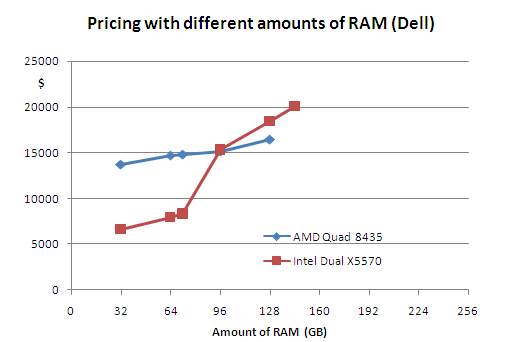Expensive Quad Sockets vs. Ubiquitous Dual Sockets
by Johan De Gelas on October 6, 2009 1:00 AM EST- Posted in
- IT Computing
Conclusion
When the Xeon X7460 "Dunnington" was launched in September 2008, our first impression was that the 503mm² chip was a brute force approach to crush AMD out of it last stronghold, the quad socket server. In hindsight, the primary reason why this server CPU impressed was the poor execution of the AMD "Barcelona" chip. Still stuck at 2.3GHz and backed by a very meager 2MB L3 cache, the AMD server platform was performing well below its true capabilities. The advantage that AMD still held was that the NUMA fast interconnect platform was capable of much more, and it was just a matter of improving the CPUs. Intel is far beyond the limits of the multiple FSB platform and needs to roll out a completely new server platform, a "QuickPath" quad socket platform. AMD has already improved their Quad socket CPU two times in one year, while Intel's updated quad platform will not be available before the beginning of 2010.
The end result is that servers based on a quad hex-core Opteron are about 20% to 50% faster, and at the same time consume 20% less than Intel hex-core. The E7450 has a slightly better performance/watt ratio, but simple mathematics show that no matter which hex-core Xeon you chose, it is going to look bad for the Intel six-core. The X7460 and its brothers are toast. The Intel quad platform will not be attractive until the Nehalem EX arrives.
Until then, we have a landslide victory for the AMD quad Opteron platform, if only the pesky dual Xeon X5570 wouldn't spoil the party. Servers based on the X55xx series are the most expensive of the dual socket market, but still cost about half (or even less than half) as much than the quad hex-core Opterons based servers. The memory slot advantage is also shrinking: an X55xx based server can realistically use 18 x 4GB or 72GB (maximum: 144GB). A quad Opteron based server typically has 32 slots and can house up to 128GB of RAM if you use affordable 4 GB DIMMs (maximum: 256GB).
Before you go for quad sockets, make sure your application scales beyond 16 cores. Most of the applications don't, and we picked only those applications (large databases, ERP and virtualization) which typically scale well, and which are the target applications for quad socket servers.
So who wins? Intel's dual socket, AMD's dual socket, or AMD's quad socket platform? The answer is that it depends on your performance/RAM ratio. The more performance you require per GB, the more interesting the dual Nehalem platform gets. The more RAM you need to obtain a certain level of performance, the more interesting the AMD quad platform gets.

For example, a small intensively used database will probably sway you towards the dual Xeon X55xx server, as it is quite a bit cheaper to acquire and the performance/watt and performance/$ ratio are better. A very large database or virtualization consolidation scenario requiring more than 72GB of RAM will probably push you towards the quad Istanbul - once you need more than 64-72GB, memory gets really expensive on the Intel dual socket platform. There are two reasons for this: 8GB DIMMs are five times more expensive than 4GB DIMMs, and DDR3 is still more costly than DDR2 (especially in large DIMMs).
So there you have it: the latest quad socket Opteron hex-core scales and performs so well that it beats the "natural" enemy, the Xeon X7460, by a large margin especially from a performance/watt point of view. At the same time, it has to sweat very hard to shake off the dual socket Intel Xeon in quite a few applications. Servers with 24 of those fast cores can only really justify their higher price by offering more and ironically cheaper memory. Choosing between a dual socket and quad socket server is mostly a matter of knowing the memory footprint of the applications you will run on it… and your own personal vision on the datacenter.
I would like to thank my colleague Tijl Deneut for his assistance.










32 Comments
View All Comments
Casper42 - Tuesday, October 6, 2009 - link
I know its late, but on page 4 of this article you say your using a Dual 2389 setup where each chip is Quad Core.Somehow that morphs into a "Quad Opteron 2389" on page 6 both in the text and in the graphic. Since a Quad 2xxx is not possible, is this a Dual 2389 or a Quad 8389?
Then on page 7 it becomes a Quad Opteron 8389
Am I losing my mind?
I see now that both a Quad 8389 and a Dual 2389 are listed in Page 4, but why on earth did you guys bounce back and forth so much between them?
JohanAnandtech - Tuesday, October 6, 2009 - link
You are not losing your mind. The Quad 2389 is a quad 8389 of course. I have fixed the error. Thanks.The dual sockets machines were mostly used to check how the software scales (MS SQL server, virtualization) and how the power consumption compares to the quad socket machines. I hope this makes it clear?